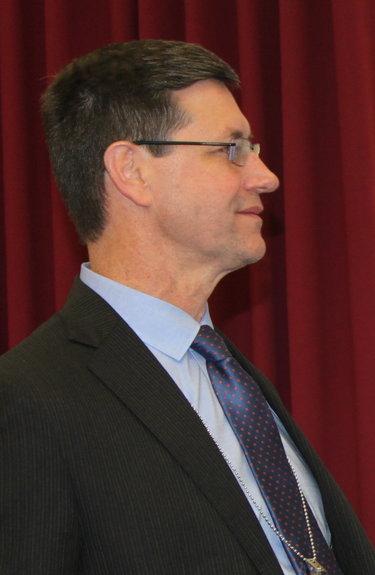Guilderland district hopes to avoid cuts as it drafts next year’s budget
GUILDERLAND — The school district here is working on what its assistant superintendent of business, Neil Sanders, called “a maintenance-of-effort budget.”
“We’re hoping to continue what we have,” he said.
Superintendent Marie Wiles will present her draft of next year’s spending plan on March 3.
Like school districts across the state, Guilderland is grappling with the governor’s new method of allocating school aid. About a quarter of Guilderland’s revenues come from the state.
“He’s changed the way he’s looking at Foundation Aid,” said Sanders of Governor Andrew Cuomo. “Foundation aid used to follow every student for a sound basic education.”
In previous years, there had been additional expenditure aid, awarded in 10 different categories to cover needs ranging from textbooks to special education.
“That was aided according to a ratio,” said Sanders. “He’s taken those 10 categories and lumped them in with Foundation Aid.”
Looking at the numbers released by the governor’s office, it at first looks as if Guilderland is slated for an increase, as Foundation Aid for next year is listed at $17.2 million.
Guilderland’s Foundation aid for this year is about $15.1 million. The district, in order to compare apples to apples, has had an analysis done that shows the governor’s aid for Guilderland next year for what would have been the old-style Foundation Aid, is actually an increase of just $77,650 — or .05 percent.
“I am really hopeful we will go beyond that,” Assemblywoman Patricia Fahy told the Guilderland School Board on Tuesday night.
Guilderland has traditionally been conservative in building its budget, and has relied on the governor's aid numbers, happy to add more later if the legislature, working with the governor, ends up giving more school aid.
One of the concerns with the single-pot method of distributing aid, Sanders said, is: “All these other aids will lose their identity … An increase in Foundation Aid might not mirror usage.”
He gave as an example the formerly separate aid for the Boards of Cooperative Educational Services. School districts across the state use BOCES services to save money, the theory being that cooperatively sharing among districts will ultimately reduce costs for taxpayers.
“It certainly won’t be the incentive it used to be,” said Sanders of using BOCES. “We won’t know what we’re getting back on those expenses.”
Guilderland’s tax-levy limit for next year, arrived at through a state-set formula, is 2.25 percent. That means the the most the district can levy in local property taxes next year is $74,990,996, which is an increase of $1,652,055 over the current year’s budget.
“It doesn’t give us a lot of room to move,” said Sanders.
The lion’s share of Guilderland’s budget, typical of all schools, is for staff salaries and benefits. Those costs are set by already-agreed-upon contracts. According to the Empire Center, the median teacher’s pay at Guilderland in 2018-19 was $74,786.
This year’s $102 million Guilderland schools budget was passed by voters, 2,145 to 1,087 — just over 66 percent of voters said yes.
The state law that sets the levy limit allows schools to go over that limit with a supermajority vote, which means that, in May, 60 percent or more of the voters would have to say “yes” to a budget that is over the levy limit rather than the simple majority of 50 percent.
Asked if Guilderland might consider this, Sanders said, “These challenges always open that discussion. We continue to ask our board. They would prefer not to, of course.”
Sanders noted that problems with the state’s massive budget deficit had put pressures on school aid. The state is facing a $6 billion deficit.
A decade ago, when there were severe cuts in state school aid, Guilderland cut scores of programs and dozens of staff members. “We were happy to put that in the rearview mirror,” said Sanders on Wednesday.
He noted several costly efforts the district has underway “to help children succeed,” including a co-teaching model that puts students with special needs in classrooms with regular students, as well as efforts to increase literacy.
“We’ve had good success with both of those,” Sanders said.
Asked if such programs or staff would have to be cut back to stay under the levy limit, Sanders said, “It’s too early to tell. We’re working through that process now … We have lots of work to do.”
He concluded, “We’re looking at all the options to present a budget that’s reasonable for taxpayers and that fulfills our mission of ensuring success for all students … It’s a challenging year.”



